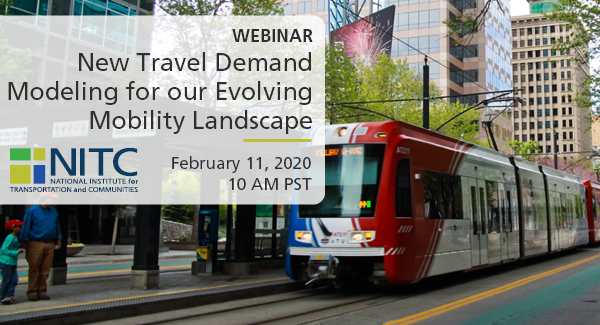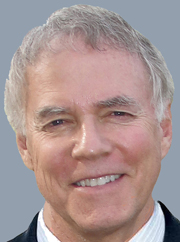
PRESENTATION ARCHIVE
OVERVIEW
Conventional four-step travel demand models are used by nearly all metropolitan planning organizations (MPOs), state departments of transportation, and local planning agencies, as the basis for long-range transportation planning in the United States. A flaw of the four-step model is its relative insensitivity to the so-called D variables. The D variables are characteristics of the built environment that are known to affect travel behavior. The Ds are development density, land use diversity, street network design, destination accessibility, and distance to transit. In this seminar, we will explain how we developed a vehicle ownership model (car shedding model), an intrazonal travel model (internal capture model), and mode choice model that consider all of the D variables based on household travel surveys and built environmental data for 32, 31, and 29 regions, respectively, validates the models, and demonstrates that the models have far better predictive accuracy than Wasatch Front Regional Council (WFRC)/Mountailand Association of Governments’ (MAG) current models.
In this webinar, researchers Reid Ewing and Sadegh Sabouri will demonstrate the effectiveness of the new travel demand model and how to implement it by integrating it into the traditional four-step process.
KEY LEARNING TAKEAWAYS
- The built environment, characterized by the so-called D variables (i.e., density, diversity, design, distance to transit, and destination accessibility), plays a pivotal role in the travel behavior of households.
- The number of vehicles owned by a household increases with socio-demographic variables and decreases with almost all of the built environment variables.
- Almost all of the Ds are found to be significant and negatively correlated with car use for one trip purpose or another, after controlling for sociodemographic variables.
- Many of the travel demand models developed by metropolitan planning organizations have low predictive accuracy since they do not consider the nesting structure of the data. Households “nested” within traffic analysis zones within regions, and the best statistical approach for nested data is multilevel modeling.
THE RESEARCH
This webinar is based on a study funded by the National Institute for Transportation and Communities (NITC) and conducted at the University of Utah. Read more about the NITC research: New Travel Demand Modeling for Our Evolving Mobility Landscape.
SPEAKERS
Reid Ewing, University of Utah
 Reid Ewing is a Distinguished Professor of City and Metropolitan Planning at the University of Utah, associate editor of the Journal of the American Planning Association, and columnist for Planning magazine. His 10 books include Pedestrian and Transit-Oriented Design, co-published by the Urban Land Institute and American Planning Association; Growing Cooler: Evidence of Urban Development and Climate Change, published by the Urban Land Institute; and Best Development Practices, listed by the American Planning Association (APA) as one of the 100 “essential” books in planning over the past 100 years. Ewing’s research focuses on the built environment at five different scales and its impacts on quality of life. He has studied the built environment at scales ranging from the individual block and pedestrian activity, to the MXD and internal capture, to the metropolitan region and mode shares.
Reid Ewing is a Distinguished Professor of City and Metropolitan Planning at the University of Utah, associate editor of the Journal of the American Planning Association, and columnist for Planning magazine. His 10 books include Pedestrian and Transit-Oriented Design, co-published by the Urban Land Institute and American Planning Association; Growing Cooler: Evidence of Urban Development and Climate Change, published by the Urban Land Institute; and Best Development Practices, listed by the American Planning Association (APA) as one of the 100 “essential” books in planning over the past 100 years. Ewing’s research focuses on the built environment at five different scales and its impacts on quality of life. He has studied the built environment at scales ranging from the individual block and pedestrian activity, to the MXD and internal capture, to the metropolitan region and mode shares.
Sadegh Sabouri, University of Utah
 Sadegh Sabouri is a Ph.D. student in the Metropolitan Planning, Policy, and Design program at the University of Utah. He received his bachelor and master of urban planning from the University of Tehran and currently, he is working as a research analyst at the Metropolitan Research Center at the University of Utah. Sabouri’s research focuses on the technologies impacts on transportation, ride-sourcing services, and advanced data analytics in urban and transportation planning. His recent papers include Intrazonal vs. Interzonal and Street life and the built environment in an auto-oriented US region, published in the Journal of Transportation and Cities Journal, respectively.
Sadegh Sabouri is a Ph.D. student in the Metropolitan Planning, Policy, and Design program at the University of Utah. He received his bachelor and master of urban planning from the University of Tehran and currently, he is working as a research analyst at the Metropolitan Research Center at the University of Utah. Sabouri’s research focuses on the technologies impacts on transportation, ride-sourcing services, and advanced data analytics in urban and transportation planning. His recent papers include Intrazonal vs. Interzonal and Street life and the built environment in an auto-oriented US region, published in the Journal of Transportation and Cities Journal, respectively.
PROFESSIONAL DEVELOPMENT
This 60-minute webinar is eligible for 1 hour of professional development credit for AICP (see our provider summary). We provide an electronic attendance certificate for other types of certification maintenance.
LEARN MORE
Photo by KuntalSaha/iStock
Sign up for our newsletter to get updates on our events.
This webinar is hosted by the Transportation Research and Education Center (TREC) at Portland State University. The research was funded by the National Institute for Transportation and Communities (NITC), a program of TREC and one of five U.S. Department of Transportation national university transportation centers. The NITC program is a Portland State-led partnership with the University of Oregon, Oregon Institute of Technology, University of Utah and new partners University of Arizona and University of Texas at Arlington. We pursue our theme — improving mobility of people and goods to build strong communities — through research, education and technology transfer.
